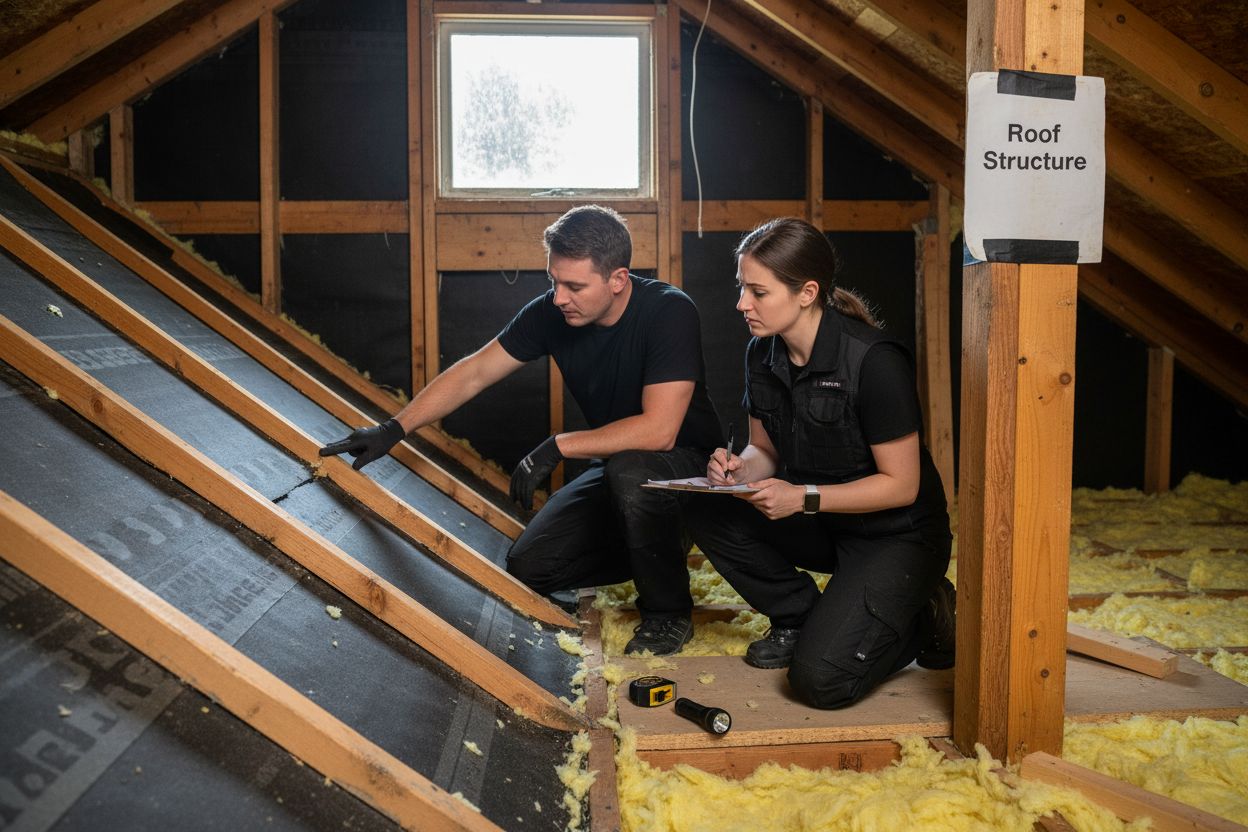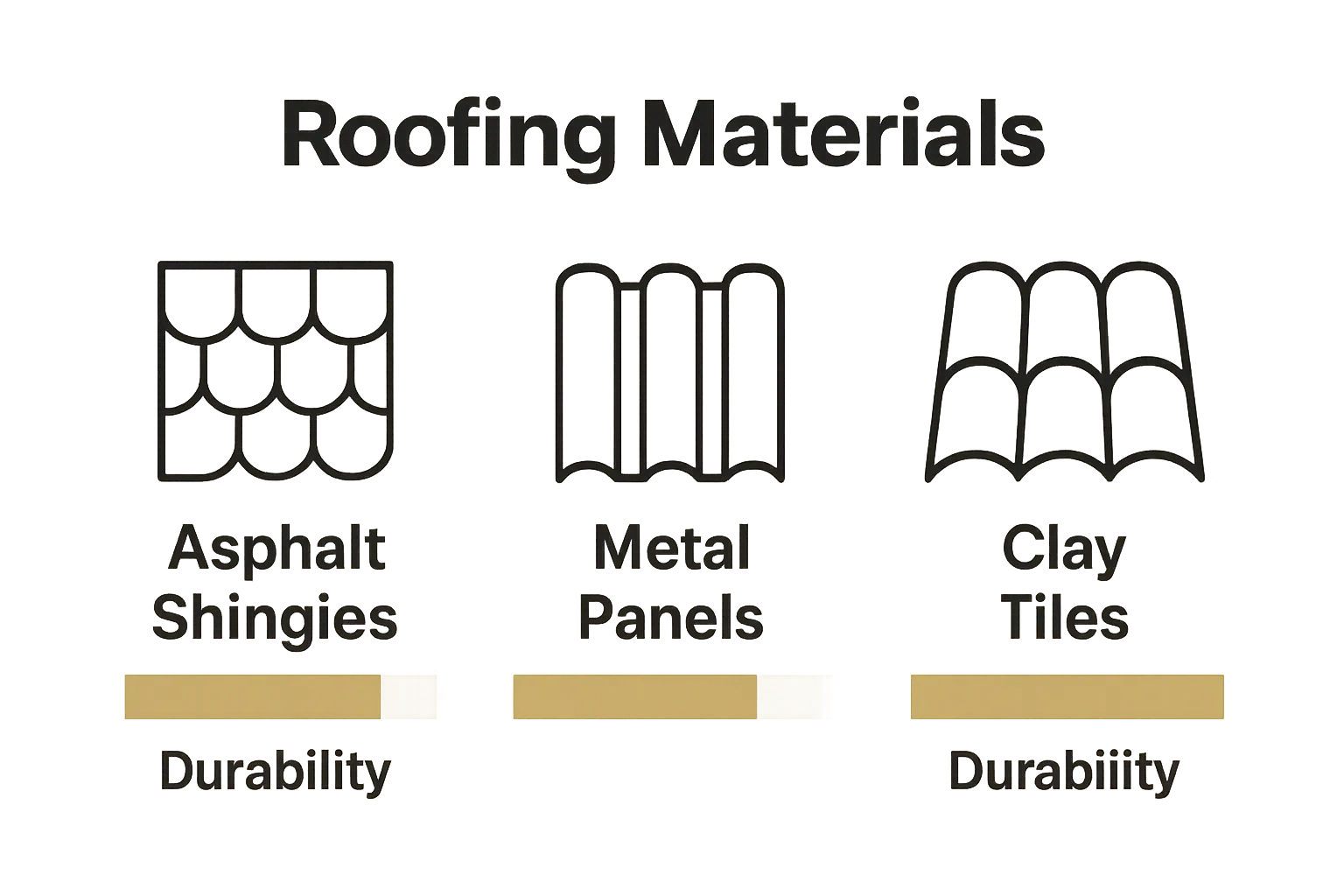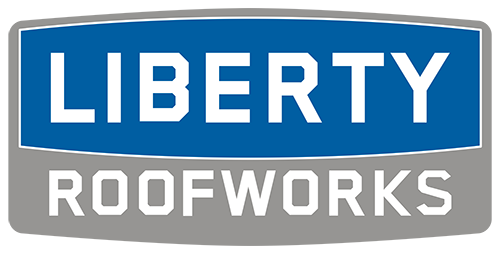Roofs are more than just the panels and shingles you see from the street. Most people never realize that a well-designed roof is built from a hidden system of components that all work together to outsmart weather and time. A well-built roof can last up to 50 percent longer than one with poor structural design and the real surprises are buried in the layers you never notice.
Table of Contents
- What Are The Essential Components Of A Roof?
- Why Each Roofing Component Is Important
- How Roofing Components Work Together
- Common Issues With Roofing Components
- Understanding Roofing Material Choices
Quick Summary
| Takeaway | Explanation |
|---|---|
| Understanding roof components is vital | Knowledge of roofing elements helps in maintenance and decision-making for owners. |
| Invest in quality materials for longevity | Higher upfront costs may lead to significant savings through durability and reduced maintenance. |
| Regular inspections prevent major issues | Early detection of problems like water damage or degradation can avert costly repairs and extend roof life. |
| Proper ventilation enhances energy efficiency | Effective ventilation systems regulate temperature and moisture, reducing energy costs significantly. |
| Choose materials based on local climate | Select roofing materials suited for specific environmental conditions to ensure maximum protection and performance. |
What Are the Essential Components of a Roof?
Understanding the key roofing components is crucial for homeowners and business owners alike. A roof is more than just a protective barrier overhead. It is a complex system designed to shield buildings from environmental elements while maintaining structural integrity. Learn more about comprehensive roofing systems to appreciate the intricate design behind effective roof construction.
Structural Framework
The roof structure begins with its fundamental framework, typically consisting of trusses or rafters. These load-bearing elements form the skeleton of the roof, supporting the entire roofing system. Roof trusses are precision-engineered wooden or metal frameworks that distribute weight evenly across the building’s walls. They provide critical support and determine the roof’s shape, pitch, and overall stability.
Key characteristics of robust roof frameworks include:
- Precise engineering to handle local wind and snow loads
- Materials selected for durability and strength
- Design that accommodates specific architectural requirements
Protective Layers
Beyond the structural framework, roofs require multiple protective layers to ensure long-term performance. The primary layers include the roof deck, underlayment, and outer roofing material. According to National Roofing Contractors Association, each layer plays a vital role in preventing water infiltration and protecting the building’s interior.
The underlayment acts as a critical moisture barrier, typically made from synthetic materials or traditional felt paper. It provides an additional shield against water and helps prevent leaks. Roofing materials such as asphalt shingles, metal panels, or tile then cover this underlayment, creating the visible and primary weather-resistant surface.
Additional Essential Components
Complete roof systems also incorporate several supplementary components that enhance performance and longevity. Roof ventilation systems, drip edges, and flashing are often overlooked but crucial elements. Proper ventilation prevents moisture buildup and regulates temperature, while drip edges and flashing direct water away from critical structural points, preventing potential water damage and extending the roof’s overall lifespan.
By understanding these essential roofing components, property owners can make informed decisions about maintenance, repairs, and potential replacements, ensuring their building remains protected and structurally sound.
The following table summarizes the essential components of a roofing system, outlining each component alongside its main function and why it is important to the overall structure.
| Component | Main Function | Importance |
|---|---|---|
| Structural Framework | Provides foundational support | Ensures stability and distributes weight across building walls |
| Roof Deck | Base for all roofing materials | Adds strength and supports underlayment and outer layers |
| Underlayment | Acts as a moisture barrier | Prevents water infiltration and protects building interior |
| Outer Roofing Material | Primary weather-resistant surface | Shields against rain, wind, snow, and UV exposure |
| Ventilation System | Regulates airflow and temperature | Prevents moisture buildup and improves energy efficiency |
| Flashing | Creates watertight seals at vulnerable junctures | Blocks potential leak points at valleys, chimneys, and vents |
| Drip Edges | Directs water away from roof edges | Prevents water damage to fascia and lower roof components |
Why Each Roofing Component Is Important
Roofing components are not just random assemblies but carefully engineered systems designed to protect buildings from environmental challenges. Learn why cheap roof systems ultimately cost more and understand the critical importance of investing in quality roofing components.
Structural Integrity and Protection
Each roofing component serves a specific purpose in maintaining the building’s structural integrity. The framework provides fundamental support, distributing weight evenly and preventing potential collapse. Trusses and rafters are engineered to withstand significant stress from environmental factors like wind, snow, and temperature fluctuations. According to Building Research Establishment, proper structural design can increase a roof’s lifespan by up to 50% compared to poorly constructed systems.
Key factors that ensure robust structural protection include:
- Precise load distribution across building walls
- Materials selected for strength and durability
- Design that accommodates regional environmental challenges
Water Management and Moisture Control
Water is a roof’s most significant threat, and each component plays a crucial role in managing moisture. Underlayment acts as a critical barrier, preventing water infiltration into the building’s interior. Flashing around chimneys, vents, and intersections creates watertight seals that block potential leak points. Proper drainage systems direct water away from the building, preventing potential water damage and structural deterioration.
Thermal and Energy Efficiency
Roofing components are not just about protection but also contribute significantly to a building’s energy performance. Ventilation systems regulate temperature and moisture, preventing heat buildup in summer and reducing condensation in winter. Reflective roofing materials and proper insulation can lower energy costs by minimizing heat transfer. Strategic component selection can result in substantial energy savings and improved indoor comfort.
By understanding the intricate roles of each roofing component, property owners can make informed decisions that protect their investments, enhance building performance, and ensure long-term structural reliability.
How Roofing Components Work Together
A roof functions as an integrated system where each component plays a critical role in protecting the building. Understand how drainage systems contribute to this complex network and appreciate the sophisticated interaction between different roofing elements.
Layered Protection Strategy
Roofing components operate like a sophisticated defense mechanism, with each layer designed to complement and reinforce the others. The structural framework provides the foundational support, while protective layers such as underlayment and outer roofing materials create multiple barriers against environmental challenges. According to Building Science Corporation, this layered approach ensures that even if one component fails, subsequent layers continue to provide protection.
Key principles of effective component interaction include:
- Seamless integration between different roofing layers
- Redundant protective mechanisms
- Synchronized moisture management
Dynamic Environmental Response
Modern roofing systems are engineered to respond dynamically to changing environmental conditions. Ventilation systems work in concert with insulation and roofing materials to regulate temperature and moisture levels. During summer, reflective surfaces and proper airflow prevent heat buildup, while in winter, the same components help prevent ice dam formation and condensation.
Moisture and Water Management
The most complex interaction occurs in water management. Flashing, underlayment, and drainage systems collaborate to redirect water away from vulnerable building structures. Drip edges guide water into gutters, while strategically placed flashing prevents water infiltration at critical junctures like roof valleys, chimneys, and vents. Proper water management is crucial in preventing long-term structural damage.
By understanding how these components work together, property owners can appreciate the sophisticated engineering behind a robust and reliable roofing system.
Common Issues with Roofing Components
Roofing systems are complex and vulnerable to various challenges that can compromise their performance. Discover the most prevalent causes of roof damage to better understand potential risks and maintenance requirements.
Structural Degradation
Structural components face significant stress from environmental factors and potential design limitations. According to International Institute of Building Envelope Experts, trusses and rafters can develop critical weaknesses over time. Common structural issues include wood rot, metal corrosion, and stress fractures that emerge from prolonged exposure to temperature fluctuations and moisture.
Key structural vulnerability indicators include:
- Sagging or uneven roof surfaces
- Visible cracks in support framework
- Evidence of wood deterioration or metal oxidation
Moisture and Water Intrusion
Moisture represents the most pervasive threat to roofing components. Compromised underlayment, improperly sealed flashing, and damaged drainage systems can create pathways for water infiltration. These vulnerabilities lead to significant problems such as mold growth, wood rot, and potential structural compromise. Water damage can progress rapidly, transforming minor issues into expensive repairs.
Material Degradation
External roofing materials endure constant environmental challenges that accelerate their deterioration. UV radiation, thermal expansion, wind stress, and precipitation contribute to gradual material breakdown. Asphalt shingles may curl or crack, metal panels can develop corrosion, and tile roofing might experience chipping or structural weakening. Regular professional inspections can help identify these issues before they escalate into more significant problems.

By understanding these common roofing component issues, property owners can implement proactive maintenance strategies that extend their roof’s lifespan and protect their building’s structural integrity.
Understanding Roofing Material Choices
Selecting the right roofing material involves careful consideration of multiple factors beyond aesthetic appeal. Learn how to choose the best roofing material for your specific needs and make an informed investment in your property’s protection.
Performance Characteristics
Roofing materials vary significantly in their performance attributes, durability, and long-term cost-effectiveness. According to Environmental Protection Agency, material selection directly impacts energy efficiency and environmental sustainability. Asphalt shingles, metal roofing, clay tiles, and synthetic materials each offer unique advantages and limitations depending on regional climate, building structure, and budget constraints.
Key performance considerations include:

- Thermal resistance and energy efficiency
- Expected lifespan under local environmental conditions
- Maintenance requirements and repair complexity
Economic and Environmental Factors
Material selection involves balancing initial installation costs with long-term performance. While some roofing materials like metal or slate have higher upfront expenses, they often provide superior durability and lower lifetime maintenance costs. Cool roof technologies can reduce energy consumption by reflecting solar radiation, potentially offering significant utility savings over the roof’s lifetime.
Climate and Structural Compatibility
Regional weather patterns play a crucial role in material selection. Areas with extreme temperatures, high precipitation, or significant wind loads require specialized roofing solutions. Coastal regions might need corrosion-resistant materials, while regions with heavy snowfall demand robust structural support. Some materials like clay tiles perform exceptionally in warm climates, while metal roofing might be preferable in areas with frequent storms.
By understanding the nuanced characteristics of different roofing materials, property owners can make strategic choices that optimize protection, efficiency, and long-term value.
This table compares common roofing material categories based on their performance characteristics, economic and environmental considerations, and climate or structural compatibility as discussed in the article.
| Material Type | Performance Characteristics | Economic/Environmental Factors | Climate/Structural Compatibility |
|---|---|---|---|
| Asphalt Shingles | Moderate thermal resistance, moderate lifespan | Lower upfront cost, higher maintenance | Versatile, suitable for many climates |
| Metal Roofing | High durability, reflective properties | Higher upfront cost, long-term savings | Great for storms, good in most regions |
| Clay Tile | Excellent heat resistance, long lifespan | Expensive, heavy, low maintenance | Best in hot/dry climates, needs robust structure |
| Synthetic | Varies, can mimic other materials | Moderate cost, sustainable options available | Depends on product, generally versatile |
| Slate | Extremely durable, natural stone appearance | High upfront cost, low maintenance, eco-friendly | Ideal for certain structures, needs strong support |
Protect Your Investment With Expert Roofing Solutions
If you have learned about the complexity of roofing components and how structural issues, moisture intrusion, and material breakdown can threaten your property, you likely realize how high the stakes are. Your roof is not just a barrier. It is a detailed system where every layer and part matters. The article highlighted how missing or damaged elements—like underlayment, flashing, or poor drainage—can lead to expensive repairs and even endanger your building’s integrity. These are more than just inconvenient problems. They can risk your comfort, safety, and financial stability.
Take control of your roof’s future today by partnering with professionals who understand the difference every critical component makes. At Liberty Roofworks, our experts deliver comprehensive roof repair and replacement services that address all the pain points discussed, from early warning signs to advanced material upgrades. Ready to ensure every layer of your roof protects your home or business for years to come? Visit Liberty Roofworks and request your inspection or repair now. Do not let small issues compromise your protection. Take action while your options are greatest.
Frequently Asked Questions
What are the main components of a roofing system?
A roofing system typically includes a structural framework (trusses or rafters), protective layers (roof deck, underlayment, and outer roofing materials), and supplementary components like ventilation, drip edges, and flashing. Each part plays a crucial role in protecting the building from environmental elements.
How does roof ventilation contribute to a roofing system?
Roof ventilation is essential for regulating temperature and moisture within the roof space. It prevents heat buildup during hot weather and reduces condensation in colder months, helping to maintain a balanced indoor environment and extending the lifespan of the roofing components.
Why is proper water management important in roofing?
Proper water management is crucial because water infiltration is one of the most significant threats to a roof. Components like underlayment, flashing, and drainage systems work together to direct water away from sensitive areas, preventing damage such as mold growth, wood rot, and structural compromise.
What factors should be considered when choosing roofing materials?
When selecting roofing materials, consider performance characteristics such as durability, thermal resistance, and energy efficiency. Additionally, evaluate economic factors like initial installation costs versus long-term maintenance expenses, as well as the compatibility of materials with the local climate and building structure.
